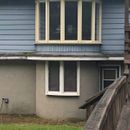Insulating Wall Assembly with Stucco Finish
I have a two story, half circle, bay window where I am insulating the framing on the ground floor of the bay. The exterior is stucco, when removing the old drywall and insulation I found tar paper attached to the framing of the bay, and with a little more investigation found that metal lath was then attached to the framing over the tar paper and then stucco on top. No sheathing or exterior insulation.
My plan is to use closed cell spray foam(I am open to other options if spray foam won’t work in this situation) in the stud bays(2×4 walls) for maximum R-value. I’m unsure of the proper way to insulate while having long term air, water and vapor control. Is it okay to spray foam up against the tar paper? or removing the tar paper and insulate against the backside of stucco? This side of the house is north facing so direct sun is very limited, if any depending on the season, and no gutters above(as of now). My worries are long term moisture control of the stucco, and if there would be any cause of degradation to the spray foam if I were to go ahead and spray against the tar paper or the stucco. should I somehow create an air gap between the foam and the backside of the exterior wall assembly?
I am in central NY. My county is in climate zone 6 but am on the edge where it is zone 5.
GBA Detail Library
A collection of one thousand construction details organized by climate and house part










Replies
Closed cell spray foam will work fine in this application so long as it doesn't contact the back of the stucco. The tar paper is serving an important function as it is creating a small but important gap between the stucco and (in this case) the framing. Stucco applied to wood frame walls is a 'drained wall' vs. a 'mass wall' so historically two layers of tar paper were applied which allowed for this drainage. Ideally this gap is paired with a through wall flashing, but in your case you are stuck with what exists.
Prior to spraying the ccsf make sure the tar paper is continuous. You may even want to add another layer from the interior. Better yet, see this great option: https://www.greenbuildingadvisor.com/article/managing-water-and-insulating-walls-without-sheathing This is an option that could avoid the plastic foam and costs of having a specialty contractor out to install it in a small space.
Josh
Makes sense. This helps a lot. Very much appreciated.